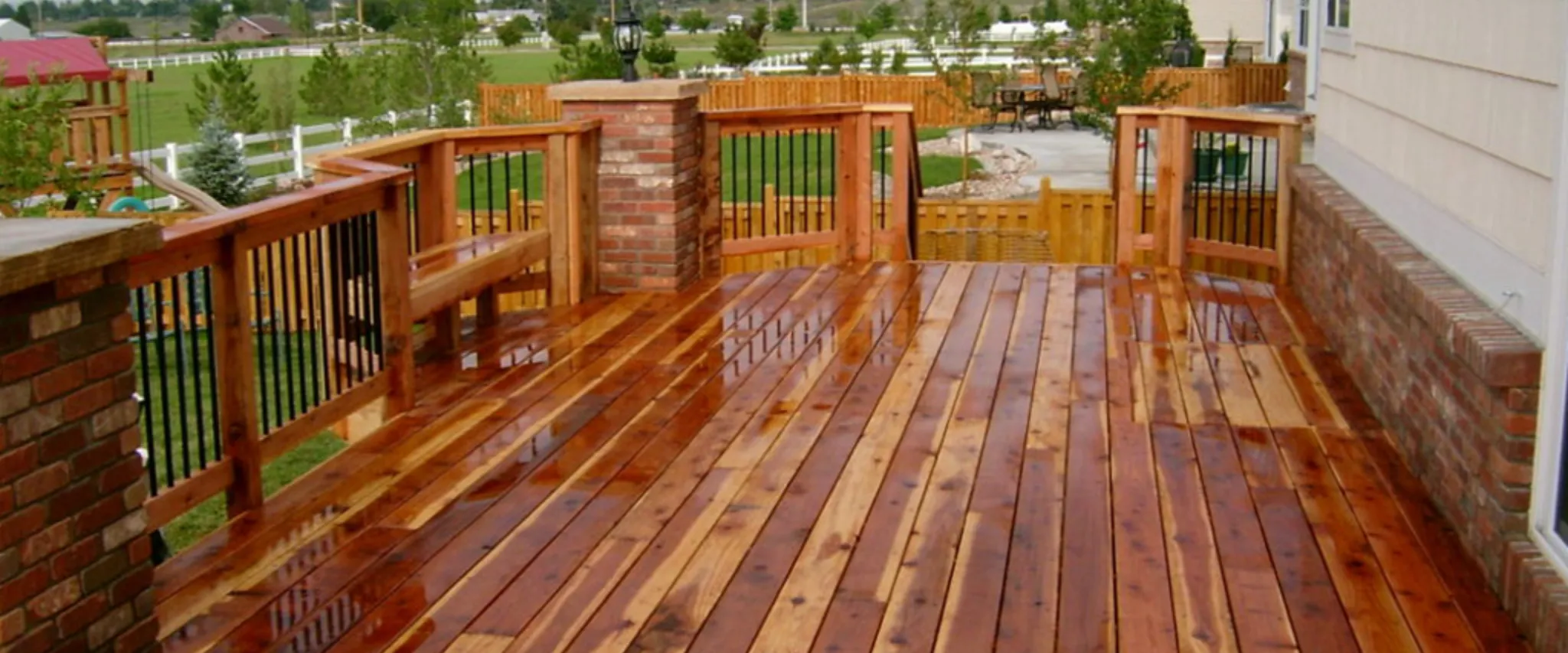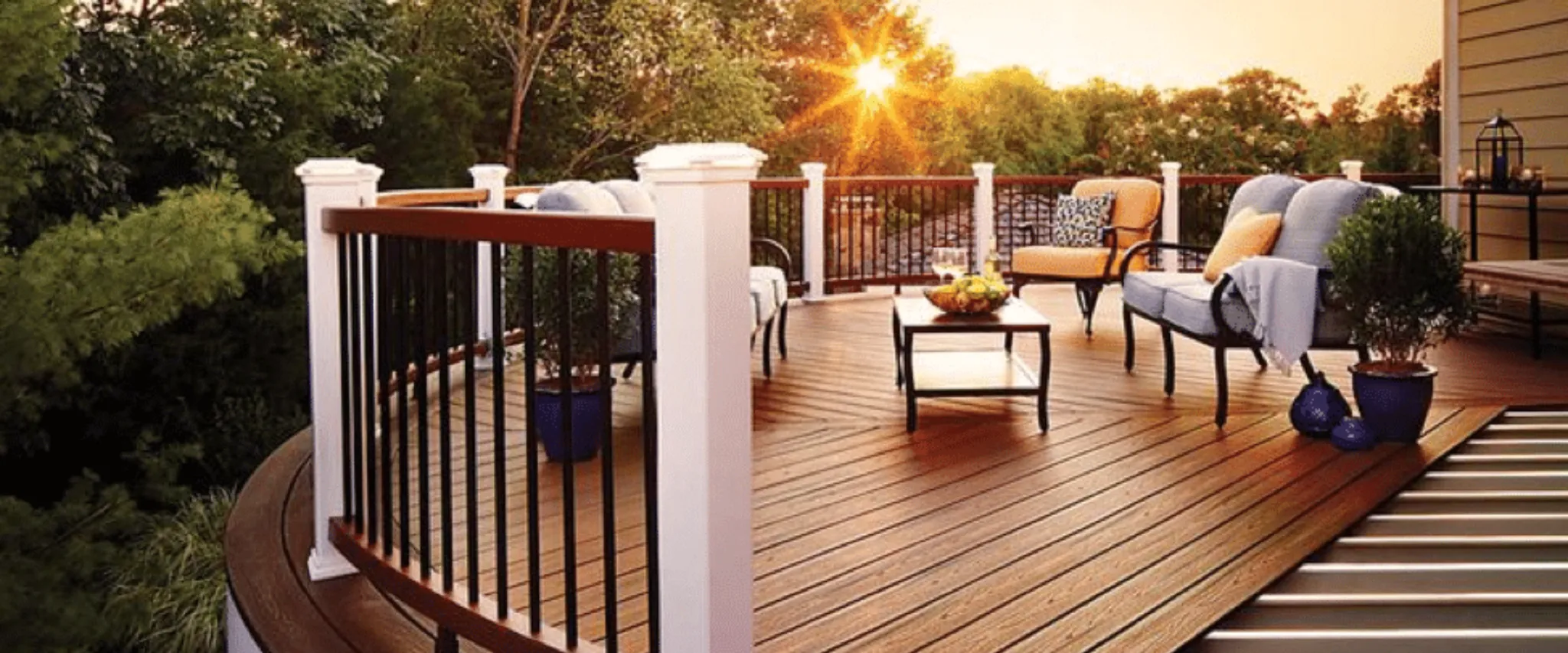Cedar Decking vs Redwood Decking: Which One is Best for Your Outdoor Space?
When building a deck, choosing the right wood can make a big difference in durability, appearance, and maintenance. Two popular options, cedar and redwood, are known for their natural beauty and weather resistance, but each has unique qualities that might make one a better fit for your outdoor space.
Here’s a breakdown of cedar decking vs. redwood decking to help you decide!

Key Takeaways
- Redwood’s higher density and natural oils make it more durable and long-lasting (20–30 years) compared to cedar, which typically lasts 15–20 years with maintenance.
- Cedar offers warm, varied tones, while redwood has a richer, more uniform reddish color. Both can develop a silver-gray patina over time if untreated.
- Cedar is more affordable and widely available, while redwood, especially in premium grades, is pricier but offers superior durability and beauty.
- Both woods need regular cleaning and sealing to retain their color, but redwood requires slightly less frequent upkeep due to its natural oils.
Overview of Cedar and Redwood Decking
Cedar Decking
Cedar decking, especially western red cedar, is a favorite for its warm, natural tones and durability. Western red cedar is prized for its rich color, ranging from reddish-brown to lighter shades, and it naturally resists decay and insects.
Cedar deck boards are lighter and tend to stay cooler in the sun, which makes them comfortable for bare feet on hot summer days. Both cedar and redwood are often chosen for their insect-resistant properties, but cedar stands out for its easy availability and affordability.
Redwood Decking
Redwood decking has a rich, deep reddish color that ages beautifully over time, making it a popular choice for homeowners who want a classic, natural look. Both redwood and cedar are naturally resistant to decay, but redwood is known for its strength and density, giving it a slight edge in durability.
Redwood decking can be a bit more costly, especially for higher grades, but it’s also long-lasting, making it worth the investment for those looking for quality.
Comparing Cedar and Redwood Decking: Key Factors
- Appearance
- Western Red Cedar: Known for its variety of warm tones, western red cedar adds a natural beauty to any outdoor space. Cedar’s smooth texture and grain are also well-suited for staining or finishing.
- Redwood: Known for its rich, deep color, redwood has a more uniform appearance, with a tighter grain than cedar. The color can range from light red to dark brown, giving it an earthy, classic look.
- Durability and Resistance
- Both cedar and redwood are highly resistant to decay and insects, making them great choices for outdoor use. Both cedar and redwood options hold up well in various weather conditions without significant warping or splintering.
- Redwood’s natural oils give it an edge when it comes to moisture and insect resistance, making it a better choice for particularly humid or wet climates.
- Maintenance
- Cedar Decking: Western red cedar requires a bit of maintenance to keep it looking fresh. A yearly cleaning and sealing will help maintain its color and prolong its life.
- Redwood Decking: Redwood generally requires similar maintenance, although it’s slightly more durable and may need less frequent treatments. Redwood’s density and natural oils also help it retain color longer than cedar deck boards.
- Environmental Impact
- Both cedar and redwood are sourced from responsibly managed forests, and many are certified by the Forest Stewardship Council (FSC), ensuring sustainable practices.
- Cedar or redwood seedlings are replanted regularly to maintain the sustainability of these resources, making both choices environmentally friendly options.
- Cost and Availability
- Cedar decking is typically more affordable and readily available in various grades. If you’re looking to save on material costs, cedar may be the better option.
- Redwood decking can be more expensive, especially in higher grades. When it comes to grade availability, redwood wins for premium, furniture-quality grades, which are known for their beauty and durability.
Pros and Cons of Cedar and Redwood Decking
- Cedar Decking Pros
- Lightweight and easy to work with.
- Stays cool in the sun.
- Available in multiple grades for different budgets.
- Naturally insect-resistant.
- Cedar Decking Cons
- Requires regular maintenance to retain color.
- Less dense than redwood, so it may wear faster in high-traffic areas.
- Redwood Decking Pros
- Rich color and tight grain for a classic look.
- Highly durable and dense.
- Resistant to moisture and insect damage.
- Premium grades are furniture-quality.
- Redwood Decking Cons
- Higher upfront cost.
- Not as widely available as cedar.

Installation and Workability
Both cedar and redwood are generally easy to work with, but there are some differences to consider if you’re thinking of a DIY project or want a specific look.
- Cedar Decking: Western red cedar is lightweight and easy to cut, making it a popular choice for DIYers and professionals alike. Its softness means that it’s easier to nail or screw without splitting, allowing for quicker installations.
Cedar is also flexible, making it a good option if you want to get creative with your deck design.
- Redwood Decking: Redwood, while slightly denser than cedar, is still relatively easy to work with, although it may require more effort to cut and install than cedar. If you’re going for a detailed or complex design, redwood’s strength can be beneficial, as it’s less likely to warp or bend over time.
However, because of its density, using high-quality tools is recommended to make the job easier.
For most standard decks, both options are fairly straightforward to install, and both work well with various deck boards, though cedar may be a bit easier on the tools.
Cedar and Redwood: Which Holds Up Better Over Time?
When investing in a deck, longevity is essential. While both cedar and redwood are durable, they age a bit differently.
- Cedar Decking: Western red cedar will naturally weather over time, turning a silver-gray color if left untreated. This can add a rustic charm, but it’s best to seal or stain cedar deck boards if you want to preserve the original color. With routine maintenance, a cedar deck can last 15–20 years, but areas with high traffic may wear down faster than redwood.
- Redwood Decking: Redwood’s natural oils and higher density give it an edge in terms of lifespan, and it generally ages beautifully with minimal color fading. Redwood decks can last 20–30 years, especially when higher-grade boards are used and proper maintenance is followed.
Both cedar and redwood can withstand the elements, but if long-term durability is a priority, redwood has the upper hand. Choosing a grade of either wood that’s best suited for outdoor use will also help maximize longevity.

FAQs
Both cedar and redwood are naturally insect-resistant, but redwood has a slight edge due to its density and natural oils, which add extra protection against pests.
When it comes to grade availability, redwood wins for premium, furniture-quality grades. These grades tend to be more durable and visually appealing, especially for high-end projects.
Both cedar and redwood require maintenance, such as annual cleaning and sealing, to retain their color and durability. However, redwood’s natural oils mean it may need less frequent treatments than cedar decking.

Choosing the Right Decking for Your Home
When choosing between cedar and redwood, consider your budget, climate, and desired maintenance level. Cedar offers a beautiful, affordable, and widely available option, while redwood provides durability and a timeless look. Whether you choose western red cedar or opt for redwood decking, both options bring natural beauty to outdoor spaces.
Ready to build the deck of your dreams? Contact Riverview Decks today at (865) 801-4545, and let’s start your deck building project!

